2015 FORD SUPER DUTY jump start
[x] Cancel search: jump startPage 4 of 84
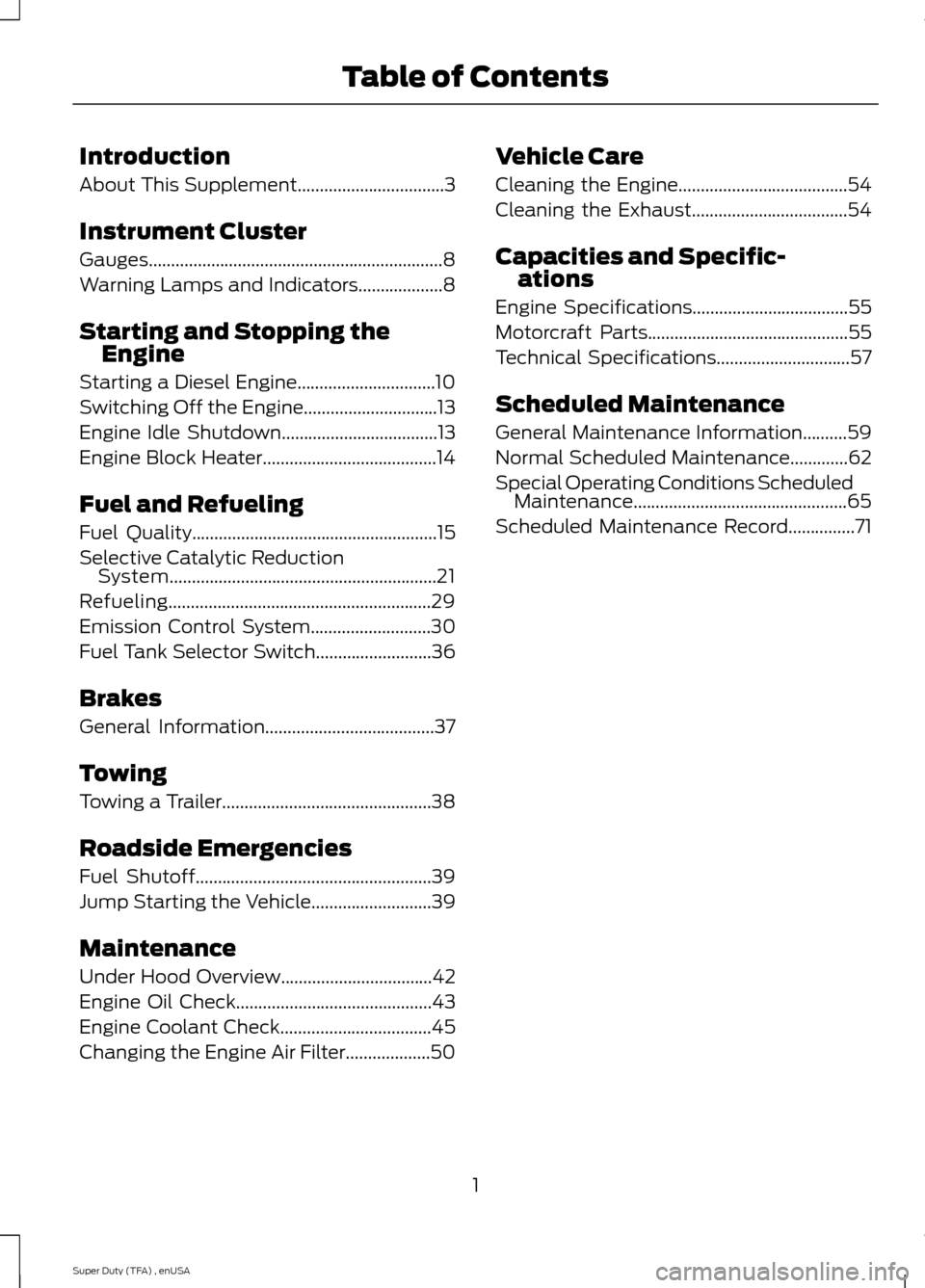
Introduction
About This Supplement.................................3
Instrument Cluster
Gauges..................................................................8
Warning Lamps and Indicators...................8
Starting and Stopping the Engine
Starting a Diesel Engine...............................10
Switching Off the Engine..............................13
Engine Idle Shutdown
...................................13
Engine Block Heater.......................................14
Fuel and Refueling
Fuel Quality
.......................................................15
Selective Catalytic Reduction System............................................................21
Refueling...........................................................29
Emission Control System
...........................30
Fuel Tank Selector Switch..........................36
Brakes
General Information......................................37
Towing
Towing a Trailer...............................................38
Roadside Emergencies
Fuel Shutoff.....................................................39
Jump Starting the Vehicle...........................39
Maintenance
Under Hood Overview..................................42
Engine Oil Check............................................43
Engine Coolant Check
..................................45
Changing the Engine Air Filter...................50 Vehicle Care
Cleaning the Engine......................................54
Cleaning the Exhaust...................................54
Capacities and Specific-
ations
Engine Specifications
...................................55
Motorcraft Parts
.............................................55
Technical Specifications
..............................57
Scheduled Maintenance
General Maintenance Information
..........59
Normal Scheduled Maintenance.............62
Special Operating Conditions Scheduled Maintenance................................................65
Scheduled Maintenance Record
...............71
1
Super Duty (TFA) , enUSA Table of Contents
Page 9 of 84
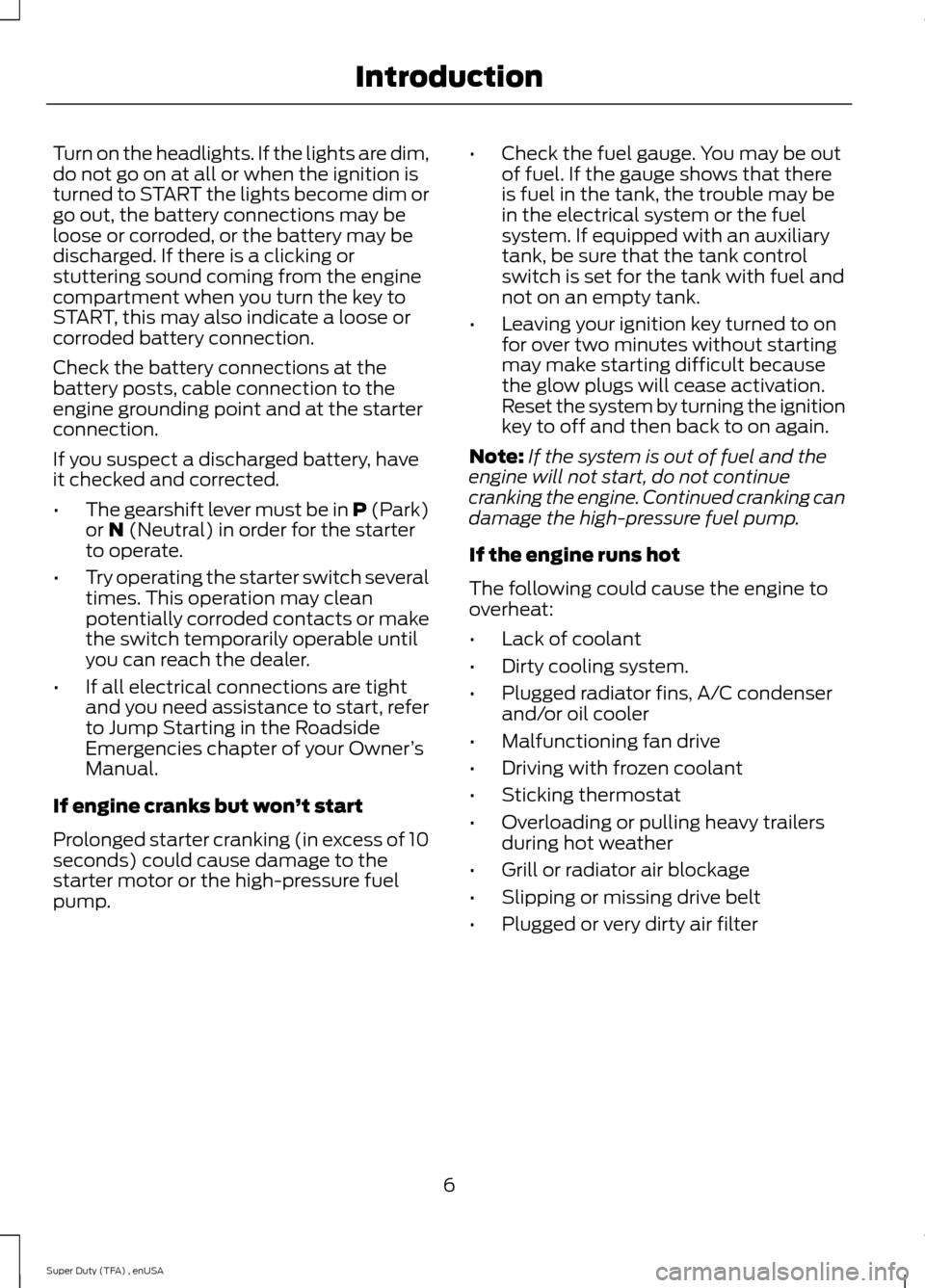
Turn on the headlights. If the lights are dim,
do not go on at all or when the ignition is
turned to START the lights become dim or
go out, the battery connections may be
loose or corroded, or the battery may be
discharged. If there is a clicking or
stuttering sound coming from the engine
compartment when you turn the key to
START, this may also indicate a loose or
corroded battery connection.
Check the battery connections at the
battery posts, cable connection to the
engine grounding point and at the starter
connection.
If you suspect a discharged battery, have
it checked and corrected.
•
The gearshift lever must be in P (Park)
or N (Neutral) in order for the starter
to operate.
• Try operating the starter switch several
times. This operation may clean
potentially corroded contacts or make
the switch temporarily operable until
you can reach the dealer.
• If all electrical connections are tight
and you need assistance to start, refer
to Jump Starting in the Roadside
Emergencies chapter of your Owner ’s
Manual.
If engine cranks but won ’t start
Prolonged starter cranking (in excess of 10
seconds) could cause damage to the
starter motor or the high-pressure fuel
pump. •
Check the fuel gauge. You may be out
of fuel. If the gauge shows that there
is fuel in the tank, the trouble may be
in the electrical system or the fuel
system. If equipped with an auxiliary
tank, be sure that the tank control
switch is set for the tank with fuel and
not on an empty tank.
• Leaving your ignition key turned to on
for over two minutes without starting
may make starting difficult because
the glow plugs will cease activation.
Reset the system by turning the ignition
key to off and then back to on again.
Note: If the system is out of fuel and the
engine will not start, do not continue
cranking the engine. Continued cranking can
damage the high-pressure fuel pump.
If the engine runs hot
The following could cause the engine to
overheat:
• Lack of coolant
• Dirty cooling system.
• Plugged radiator fins, A/C condenser
and/or oil cooler
• Malfunctioning fan drive
• Driving with frozen coolant
• Sticking thermostat
• Overloading or pulling heavy trailers
during hot weather
• Grill or radiator air blockage
• Slipping or missing drive belt
• Plugged or very dirty air filter
6
Super Duty (TFA) , enUSA Introduction
Page 42 of 84
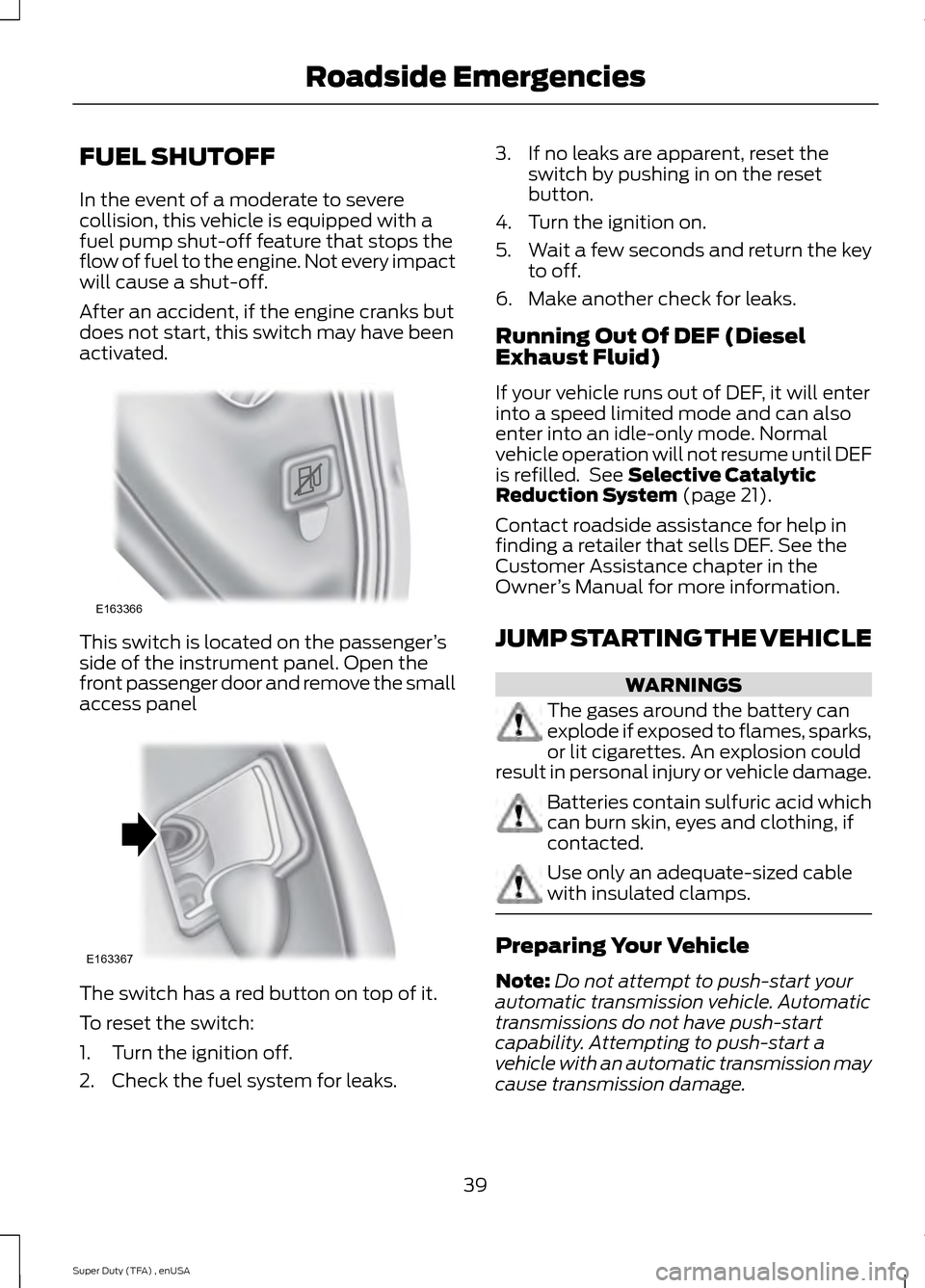
FUEL SHUTOFF
In the event of a moderate to severe
collision, this vehicle is equipped with a
fuel pump shut-off feature that stops the
flow of fuel to the engine. Not every impact
will cause a shut-off.
After an accident, if the engine cranks but
does not start, this switch may have been
activated.
This switch is located on the passenger
’s
side of the instrument panel. Open the
front passenger door and remove the small
access panel The switch has a red button on top of it.
To reset the switch:
1. Turn the ignition off.
2. Check the fuel system for leaks. 3. If no leaks are apparent, reset the
switch by pushing in on the reset
button.
4. Turn the ignition on.
5. Wait a few seconds and return the key
to off.
6. Make another check for leaks.
Running Out Of DEF (Diesel
Exhaust Fluid)
If your vehicle runs out of DEF, it will enter
into a speed limited mode and can also
enter into an idle-only mode. Normal
vehicle operation will not resume until DEF
is refilled. See Selective Catalytic
Reduction System (page 21).
Contact roadside assistance for help in
finding a retailer that sells DEF. See the
Customer Assistance chapter in the
Owner ’s Manual for more information.
JUMP STARTING THE VEHICLE WARNINGS
The gases around the battery can
explode if exposed to flames, sparks,
or lit cigarettes. An explosion could
result in personal injury or vehicle damage. Batteries contain sulfuric acid which
can burn skin, eyes and clothing, if
contacted.
Use only an adequate-sized cable
with insulated clamps.
Preparing Your Vehicle
Note:
Do not attempt to push-start your
automatic transmission vehicle. Automatic
transmissions do not have push-start
capability. Attempting to push-start a
vehicle with an automatic transmission may
cause transmission damage.
39
Super Duty (TFA) , enUSA Roadside EmergenciesE163366 E163367
Page 43 of 84
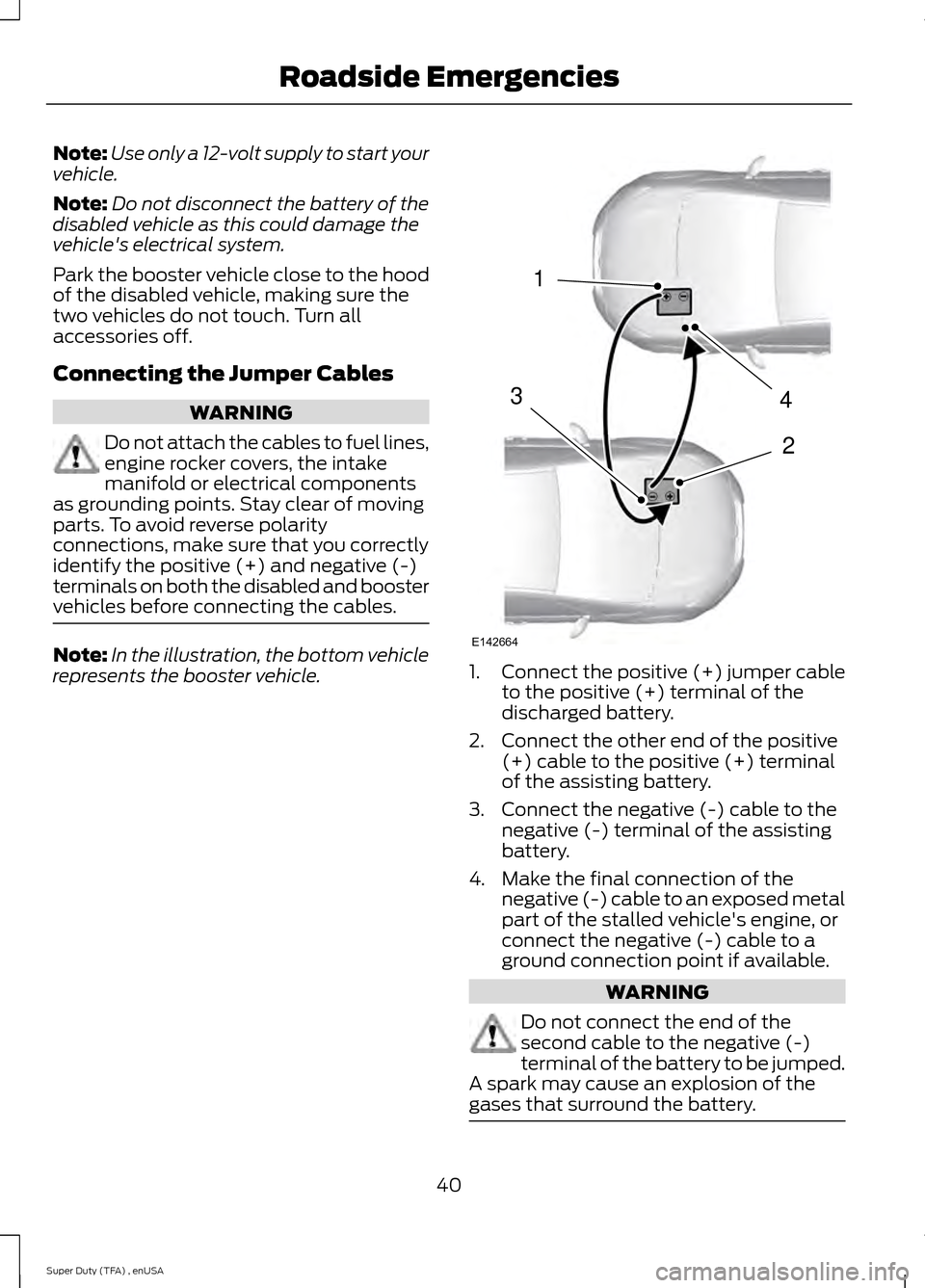
Note:
Use only a 12-volt supply to start your
vehicle.
Note: Do not disconnect the battery of the
disabled vehicle as this could damage the
vehicle's electrical system.
Park the booster vehicle close to the hood
of the disabled vehicle, making sure the
two vehicles do not touch. Turn all
accessories off.
Connecting the Jumper Cables WARNING
Do not attach the cables to fuel lines,
engine rocker covers, the intake
manifold or electrical components
as grounding points. Stay clear of moving
parts. To avoid reverse polarity
connections, make sure that you correctly
identify the positive (+) and negative (-)
terminals on both the disabled and booster
vehicles before connecting the cables. Note:
In the illustration, the bottom vehicle
represents the booster vehicle. 1.
Connect the positive (+) jumper cable
to the positive (+) terminal of the
discharged battery.
2. Connect the other end of the positive (+) cable to the positive (+) terminal
of the assisting battery.
3. Connect the negative (-) cable to the negative (-) terminal of the assisting
battery.
4. Make the final connection of the negative (-) cable to an exposed metal
part of the stalled vehicle's engine, or
connect the negative (-) cable to a
ground connection point if available. WARNING
Do not connect the end of the
second cable to the negative (-)
terminal of the battery to be jumped.
A spark may cause an explosion of the
gases that surround the battery. 40
Super Duty (TFA) , enUSA Roadside Emergencies4
2
1
3
E142664
Page 44 of 84
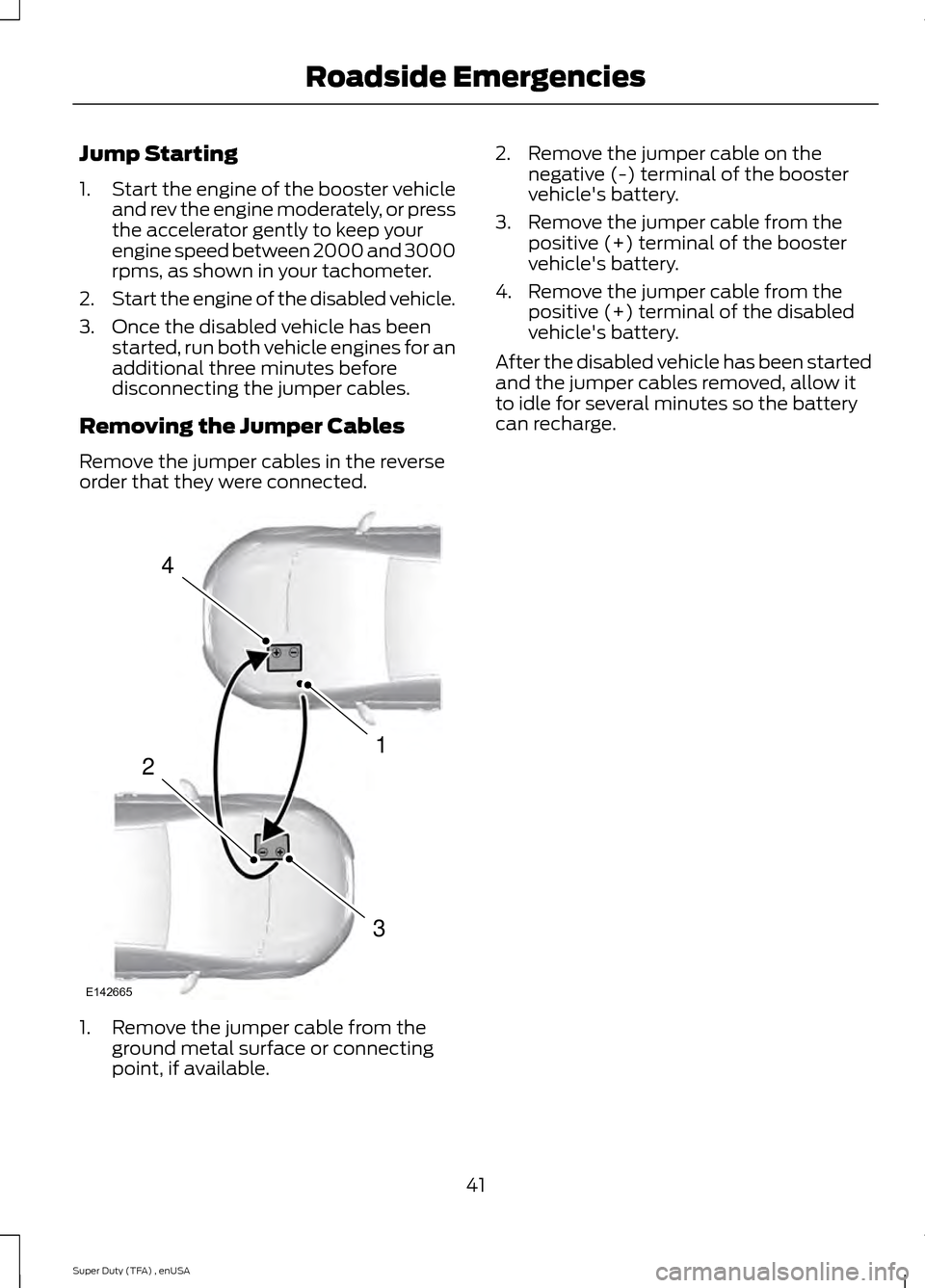
Jump Starting
1.
Start the engine of the booster vehicle
and rev the engine moderately, or press
the accelerator gently to keep your
engine speed between 2000 and 3000
rpms, as shown in your tachometer.
2. Start the engine of the disabled vehicle.
3. Once the disabled vehicle has been started, run both vehicle engines for an
additional three minutes before
disconnecting the jumper cables.
Removing the Jumper Cables
Remove the jumper cables in the reverse
order that they were connected. 1. Remove the jumper cable from the
ground metal surface or connecting
point, if available. 2. Remove the jumper cable on the
negative (-) terminal of the booster
vehicle's battery.
3. Remove the jumper cable from the positive (+) terminal of the booster
vehicle's battery.
4. Remove the jumper cable from the positive (+) terminal of the disabled
vehicle's battery.
After the disabled vehicle has been started
and the jumper cables removed, allow it
to idle for several minutes so the battery
can recharge.
41
Super Duty (TFA) , enUSA Roadside Emergencies4
1
3
2
E142665
Page 83 of 84
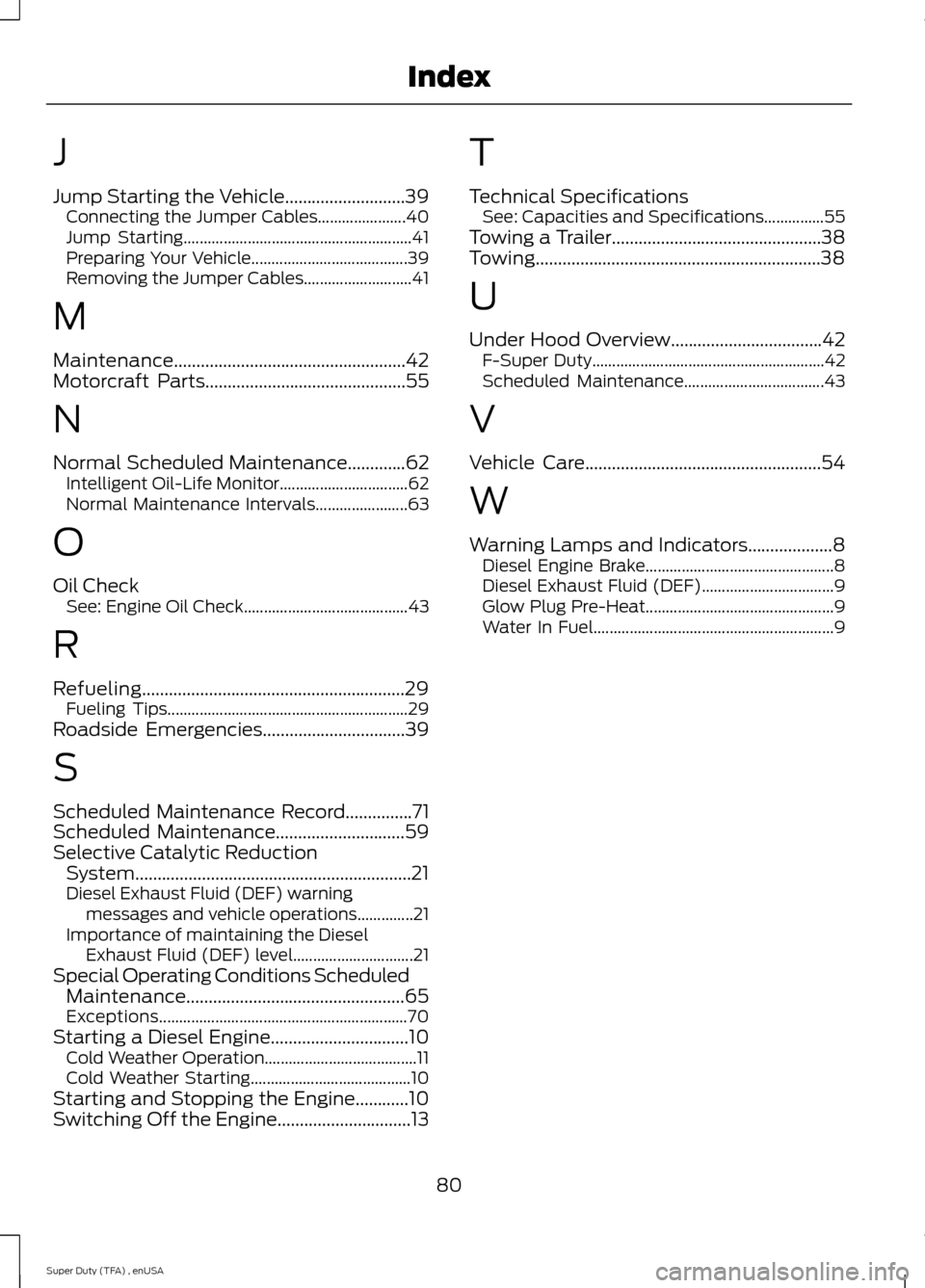
J
Jump Starting the Vehicle...........................39
Connecting the Jumper Cables...................... 40
Jump Starting......................................................... 41
Preparing Your Vehicle....................................... 39
Removing the Jumper Cables........................... 41
M
Maintenance....................................................42
Motorcraft Parts.............................................55
N
Normal Scheduled Maintenance.............62 Intelligent Oil-Life Monitor................................ 62
Normal Maintenance Intervals....................... 63
O
Oil Check See: Engine Oil Check......................................... 43
R
Refueling...........................................................29 Fueling Tips............................................................ 29
Roadside Emergencies
................................39
S
Scheduled Maintenance Record...............71
Scheduled Maintenance.............................59
Selective Catalytic Reduction System..............................................................21
Diesel Exhaust Fluid (DEF) warning messages and vehicle operations..............21
Importance of maintaining the Diesel Exhaust Fluid (DEF) level.............................. 21
Special Operating Conditions Scheduled Maintenance.................................................65
Exceptions.............................................................. 70
Starting a Diesel Engine...............................10 Cold Weather Operation...................................... 11
Cold Weather Starting........................................ 10
Starting and Stopping the Engine............10
Switching Off the Engine..............................13 T
Technical Specifications
See: Capacities and Specifications...............55
Towing a Trailer...............................................38
Towing................................................................38
U
Under Hood Overview..................................42 F-Super Duty.......................................................... 42
Scheduled Maintenance................................... 43
V
Vehicle Care
.....................................................54
W
Warning Lamps and Indicators...................8 Diesel Engine Brake............................................... 8
Diesel Exhaust Fluid (DEF)................................. 9
Glow Plug Pre-Heat............................................... 9
Water In Fuel............................................................ 9
80
Super Duty (TFA) , enUSA Index